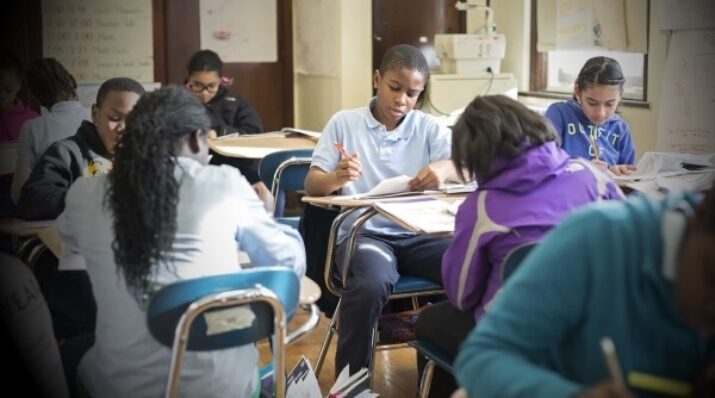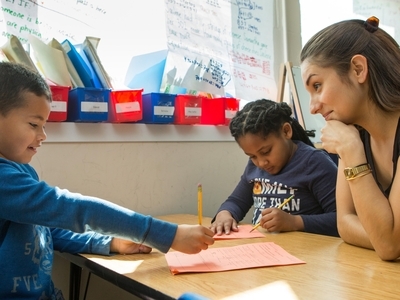How Community Partners and Schools Work Together to Re-Engage Students in Learning
Topics

Next generation learning is all about everyone in the system—from students through teachers to policymakers—taking charge of their own learning, development, and work. That doesn’t happen by forcing change through mandates and compliance. It happens by creating the environment and the equity of opportunity for everyone in the system to do their best possible work.
Through early intervention and concerted efforts to re-engage students, schools and their community partners can address chronic absenteeism and the negative consequences of students disengaging from school.
I'll never forget the excitement of starting kindergarten. School was a magical place filled with friends, games, and endless possibilities. But as the years passed, that initial spark began to dim. By seventh grade, I found myself feeling lost and alone. The familiar faces of elementary school were replaced by a sea of strangers, and I struggled to find my place.
Academically, I was doing fine. My mother had always instilled in me the importance of education, and I was determined to meet her expectations. Honestly, my sense of obligation to meet my mother's high expectations is what helped me to excel academically, it wasn't out of genuine passion. Beyond the classroom, I felt like a ghost. I longed to connect with others, to be seen and heard, but I was plagued by self-doubt and insecurity.
Who hasn’t felt out of place at some point during their school years?
I can certainly recall moments throughout my education where I wasn't the most engaged. While the early grades were a breeze, the transition to middle school (and then again into high school after the traumatic experience of losing my mother and sole caregiver) brought a whirlwind of changes that left me feeling adrift. As I navigated a new environment and sought to fit in, I began to question my identity.
Sounds scary, doesn’t it? It was. Fortunately, there was a silver lining: the after-school and mentorship programs. These initiatives offered a space where I could truly be myself, express my creativity, and find a sense of belonging. It was in these programs that I discovered a spark within me, one that fueled my academic pursuits and boosted my self-confidence. I even found grief counseling and support through a school-based program.
Not much has changed from my school days. Today’s students face many of the same challenges and rely on support from schools, community resources, and partnerships. But to make a difference, the partnerships have to be those that spark the interest and address the needs of the student to sustain their engagement, and they have to work in alignment with district goals.
Boston Public Schools' Office of Partnerships plays a crucial role in bridging the gap between the school system and the community. Yes, student enrollment is increasing in early and elementary education. However, trends suggest a growing disengagement among youth at later academic stages, contributing to the challenge of chronic absenteeism.
What Are Youth Telling Us?
Schools are often the first to identify signs of disengagement. By implementing effective strategies, they can intervene early, preventing the negative consequences that can arise from prolonged disengagement. Schools in collaboration with partners can tailor their approaches to individual students' needs, providing personalized support and guidance. This can help students feel valued and motivated to participate. However, the right school-based partnership matters. Implementing an ineffective partnership or program can have a negative impact and work against engagement efforts.
Youth disengagement from school-based partnerships can manifest in various ways, including:
- Reduced participation: Fewer students attending after-school programs, clubs, or community events.
- Lack of interest: Students expressing apathy or disinterest in school-based initiatives.
- Behavioral issues: Increased instances of disruptive behavior or academic challenges.
These actions often reflect underlying concerns, such as:
- Overwhelming workload: Students may feel overburdened with academic responsibilities and extracurricular activities.
- Lack of relevance: Students may feel that school programs do not align with their interests or career goals.
- Limited access: Students may face barriers to participation, such as transportation or families may face childcare issues.
Providing a positive school climate (i.e., fostering strong relationships, communicating expectations, nurturing a sense of belonging) can significantly reduce disengagement. School-partner relationships can contribute to creating such an environment.
Schools and their community partners have implemented a variety of strategies to address youth disengagement. Some examples include:
- Personalized learning: Tailoring curriculum and activities to individual student needs and interests.
- Mentorship programs: Connecting students with adult mentors who can provide guidance and support.
- Community partnerships: Collaborating with local organizations to offer relevant and engaging programs.
- Flexible scheduling: Providing students a variety of partnerships to choose from that fit their schedules.
While these efforts have shown promise, the effectiveness of each solution can vary depending on factors such as school culture, student culture and demographics, and community resources.
What Works?
Successful strategies for addressing youth disengagement often involve a combination of the following elements:
- Student-centered approach: Prioritizing students' voices and perspectives in program design and implementation.
- Authentic partnerships: Building genuine relationships with community-based partners, resources, and local businesses.
- Data-driven decision-making: Capturing and using data to evaluate and improve programming.
- Continuous evaluation: Conducting regular assessments of the impact of programs and making adjustments as needed or opting out (and understanding that it’s ok if something isn’t a good fit).
At BPS, one of our long standing collaborators is Boston Partners in Education (BPiE). This organization has been a great resource in addressing student disengagement. By pairing students with dedicated mentors, BPiE provides a personalized and supportive environment that fosters academic success and personal growth.
As proactive as we want to be, some students still fall through the cracks. What do we do when the student has already become disengaged? We must work to re-engage them. Inspired by the work and success of the Boston Private Industry Council (Boston PIC) to re-enroll Boston Public School students by hiring re-engagement specialists, BPS established The Re-Engagement Center (REC). Working in partnership with Boston PIC, the REC is the only Boston Public Schools program that targets dropouts. The REC has a caring staff and offers students access to the resources and counseling they need to re-enroll in school and get back on track to graduate.
By focusing on these key principles and continuing to build strong collaborative relations, BPS is creating more engaging and effective partnerships that foster youth participation. We have also found that addressing disengagement in the early years can help lead to a favorable and lasting impact on students. It can help them develop important skills such as self-accountability, resilience, problem-solving, and self-advocacy. By investing in action plans to address disengagement, schools can improve students' overall academic performance. Engaged students are more likely to achieve academic success. It certainly worked for me.
Photo at top courtesy of Boston Public Schools.




